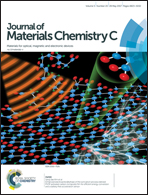Carbon quantum dots in ionic liquids: a new generation of environmentally benign photoluminescent inks†
Abstract
Carbon quantum dots (CQDs) have appeared as attractive photoluminescent (PL) materials that overcome the poor photostability of organic dyes and the environmental hazards of heavy metal-containing quantum dots. Engineering CQDs into PL inks that can find applications in anti-counterfeiting and information encryption is promising. However, current methodologies are limited by several disadvantages, including blocking of the writing/printing tools caused by the slow evaporation of the solvent and the aggregation-induced quenching of CQDs in their dry state, when practical applications are concerned. Herein, a new generation of CQD-based PL inks applying room-temperature ionic liquids (RTILs) as the solvent was prepared. The concept presented herein relies on functionalizing the CQDs with the same or similar cationic moieties as those involved in RTILs and facilely obtaining the PL inks through a one-step phase transfer of the as-prepared water-soluble CQDs to the hydrophobic RTILs. The so-obtained CQDs/RTILs inks are highly photoluminescent and compatible with most commonly used writing and templating tools including gel ink pens, brush pens and stamps. Letters or patterns obtained by these PL inks show impressive photostability under various harsh conditions.



 Please wait while we load your content...
Please wait while we load your content...